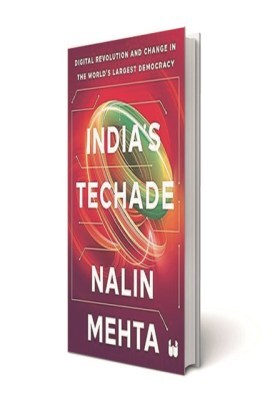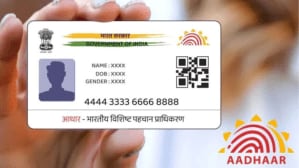By Shivaji Dasgupta
At a foundation level, Nalin Mehta’s effort is a case study propelled by staggering statistics. As an elevated opinion, it is undeniable evidence of the success of Indian democracy, as citizen-centric efficacy and not just emotive air cover.
This is a compelling biography of the India Tech Stack, otherwise known as Digital Public Infrastructure (DPI), driven by the planks of identity, payments and data management. On identity, the proof is nearly 1.4 million Aadhaar enrolments by 2022. Its equivalent in payments is the blockbuster UPI, which is reflecting record transactions at over Rs 15 trillion. The data aggregation piece is backed by 140 million users of Digilocker until recently. No prizes for surmising that the numbers are only going northwards at Vande Bharat pace, stunning every knowing stakeholder and observer.
Loosely structured as an interplay of The Build, The Play, UPI and Hardware, the salient factual features are many. The JAM trinity (Jan Dhan, Aadhaar and Mobile), for instance, being confirmed by a mobile phone penetration of 85%, a Rs 10 price point for a single GB of data and an average usage of nearly 20 GB per month. Not to mention a banking penetration in excess of 80%, which is an iconic datapoint given our historical barriers. Most significantly, the kingsize momentum being driven by rural and women audiences, both previously contributing way less to the pie.

The author goes on to describe the magic of the Common Service Centres, acting as an able intermediary between the tech-challenged citizen and the tech-empowered future, thereby accelerating adoption even for the lowest common denominator. In many ways, the cornerstone of this revolution is DBT (Direct Benefit Transfers), wherein monies are sent directly to the end beneficiary, eliminating the debilitating trap of middlemen, often state actors, capable of usurping even 80% of the designated largesse.
A notable data point is that food security and fertilisers account for more than half of the distributed funds. Ample mention is made of PMAY(G), the subsidy of Rs 1,20,000 per person towards building homes, and a Swachh Bharat equivalent of `12,000 per person towards toilets. Both are potent examples of the DPI, from identity to DBT.
The detailed section on UPI shares light on multiple facts—digital for public good, rural-first focus, organic scalability, global adaptability and gestalt in implementation. The rapidly escalating international compatibility of our indigenous technology is most impressive, the association with Singapore’s PayNow being a stellar feather in the cap, ably supplemented by a multitude of other networks, from continental Europe, United Kingdom to Bhutan. It seems the equivalent of China’s BRI (Belt and Road Initiative) in a positive and friendly tonality, expanding the potent influence and not just soft power of India.
To complete the scheduled flow of thoughts, there is a suitable section on hardware which reinforces the foundational thinking prior to the mammoth rollout orchestrated by OFC (optical fibre cable) expertise. Then, quite suitably, a trip to the future, most importantly the imminent 5G evolution, where already India’s installed capacity is making the western world rise up in awe. There is a necessary reference to the AI intrigue, and how we are possibly more ready than most others to take advantage wherever applicable and profitable, such is our prolificity. Suitable caveats are certainly not ignored, in this case the concerns about state surveillance and data security, given the arguably Orwellian access to personal actions. Judgements are not passed, in tune with every other scenario, but flags are duly raised on a deeply bullish yet thought-provoking note.
All of the above is indeed part of a mammoth exposition of indisputable evidence, as numbers do not lie. But there are a few underlying pipelines of opinion, or perhaps conviction, that must be raised to the surface. First is a seamlessness across political agendas, as a whole lot of kick-off points during the fag end of Manmohan Singh’s tenure were brought to life by Narendra Modi’s tenacity for execution. Like a handing of batons in a democracy relay, where the resident is truly the solitary winner.
Then, a mildly stated but adequately emphasised connectivity between state performance and political affiliation, driven by the timeless credo of ‘what’s in it for me?’ wherein the transference of benefits in a directly tangible fashion helps define who the citizen wishes to vote for. In fact, it has become a tipping point for moving to newer pastures, to those who genuinely deliver a use case for the larger agenda of parliamentary democracy, the gratification of the common man and woman.
Most importantly, this is an advocacy for the success of relentless and rigorous execution, a hitherto corporate value wonderfully applicable as statecraft, as well as a lesson in customer centricity, as everything that was done was designed from the perspective of the end user, and not just a fake demonstration agenda. The author brings such aspects to life in a charmingly open-hearted manner, licensing every reader to offer her desired interpretation.
On this hearty and indulgent note, this review must suitably conclude that this book is a good read if you are a fan of deliverance data. It is surely a must read in case you subscribe to the success of India. But for all those who believe deeply in the furtherance of the global human race, this is simply unmissable.
Mehta lays bare a success formula that is aligned to the ‘every’ and not just the ‘special’ of the species we belong to. There is no room for opportunism, instead there is adulation of opportunity. Could more use cases be applied in the discourse? Possibly so. But without doubt, this is the India story as we live it. Every day, every moment, for everyone.
India’s Techade: Digital Revolution and Change in the World’s Largest Democracy
Nalin Mehta
Westland Books
Pp 184, Rs 599
The author is an autonomous brand consultant and writer









